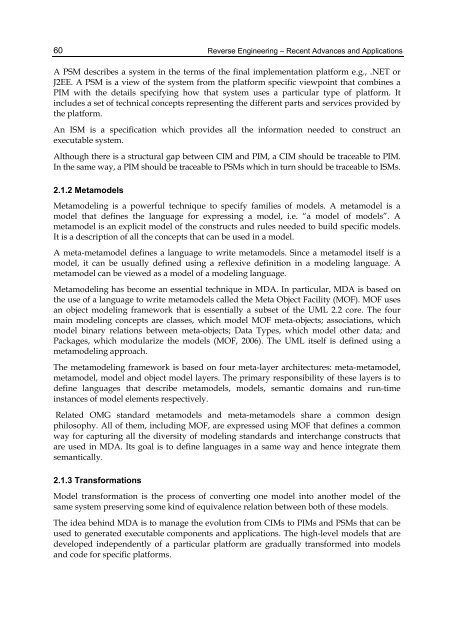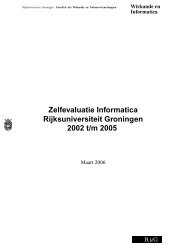Reverse Engineering – Recent Advances and Applications
Reverse Engineering – Recent Advances and Applications
Reverse Engineering – Recent Advances and Applications
Create successful ePaper yourself
Turn your PDF publications into a flip-book with our unique Google optimized e-Paper software.
60<br />
<strong>Reverse</strong> <strong>Engineering</strong> <strong>–</strong> <strong>Recent</strong> <strong>Advances</strong> <strong>and</strong> <strong>Applications</strong><br />
A PSM describes a system in the terms of the final implementation platform e.g., .NET or<br />
J2EE. A PSM is a view of the system from the platform specific viewpoint that combines a<br />
PIM with the details specifying how that system uses a particular type of platform. It<br />
includes a set of technical concepts representing the different parts <strong>and</strong> services provided by<br />
the platform.<br />
An ISM is a specification which provides all the information needed to construct an<br />
executable system.<br />
Although there is a structural gap between CIM <strong>and</strong> PIM, a CIM should be traceable to PIM.<br />
In the same way, a PIM should be traceable to PSMs which in turn should be traceable to ISMs.<br />
2.1.2 Metamodels<br />
Metamodeling is a powerful technique to specify families of models. A metamodel is a<br />
model that defines the language for expressing a model, i.e. “a model of models”. A<br />
metamodel is an explicit model of the constructs <strong>and</strong> rules needed to build specific models.<br />
It is a description of all the concepts that can be used in a model.<br />
A meta-metamodel defines a language to write metamodels. Since a metamodel itself is a<br />
model, it can be usually defined using a reflexive definition in a modeling language. A<br />
metamodel can be viewed as a model of a modeling language.<br />
Metamodeling has become an essential technique in MDA. In particular, MDA is based on<br />
the use of a language to write metamodels called the Meta Object Facility (MOF). MOF uses<br />
an object modeling framework that is essentially a subset of the UML 2.2 core. The four<br />
main modeling concepts are classes, which model MOF meta-objects; associations, which<br />
model binary relations between meta-objects; Data Types, which model other data; <strong>and</strong><br />
Packages, which modularize the models (MOF, 2006). The UML itself is defined using a<br />
metamodeling approach.<br />
The metamodeling framework is based on four meta-layer architectures: meta-metamodel,<br />
metamodel, model <strong>and</strong> object model layers. The primary responsibility of these layers is to<br />
define languages that describe metamodels, models, semantic domains <strong>and</strong> run-time<br />
instances of model elements respectively.<br />
Related OMG st<strong>and</strong>ard metamodels <strong>and</strong> meta-metamodels share a common design<br />
philosophy. All of them, including MOF, are expressed using MOF that defines a common<br />
way for capturing all the diversity of modeling st<strong>and</strong>ards <strong>and</strong> interchange constructs that<br />
are used in MDA. Its goal is to define languages in a same way <strong>and</strong> hence integrate them<br />
semantically.<br />
2.1.3 Transformations<br />
Model transformation is the process of converting one model into another model of the<br />
same system preserving some kind of equivalence relation between both of these models.<br />
The idea behind MDA is to manage the evolution from CIMs to PIMs <strong>and</strong> PSMs that can be<br />
used to generated executable components <strong>and</strong> applications. The high-level models that are<br />
developed independently of a particular platform are gradually transformed into models<br />
<strong>and</strong> code for specific platforms.




